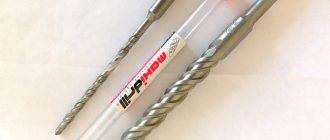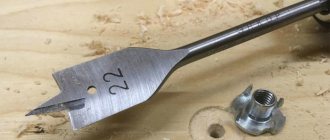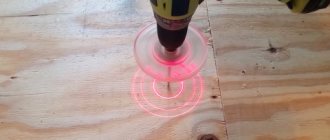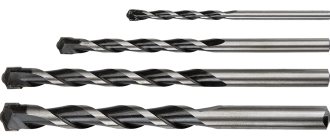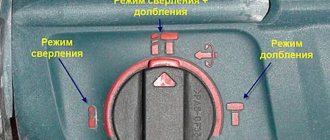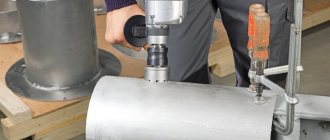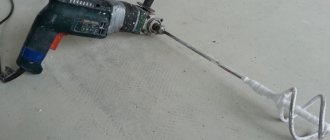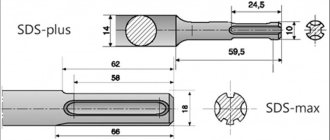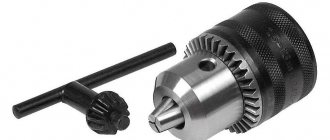“Win” or not “win”
The Pobedit alloy, invented in the first quarter of the last century, consisted of 96% tungsten carbide and 4% cobalt. In the modern classification according to GOST, such a material corresponds to an alloy under the index VK4. The number in the marking of hard alloys indicates the percentage of cobalt. Nowadays, for carbide drill tips, most manufacturers use VK8 alloy (92% tungsten carbide and 8% cobalt). Special additives are added to the alloy to improve cutting performance and extend the service life of products with carbide tips. However, due to the ingrained habit of the people, the drill for working on concrete, brick, stone, glass or tile remained “Pobedit”.
Drill color
The first criterion by which you can independently determine the quality of the instrument offered to you is its appearance, in particular, color. Experts note the following features:
- Grey. If the metal looks exactly this shade, then you are being offered the most unreliable option - these drills have not undergone any treatment to harden and increase resistance to deformation and combustion. Yes, the price of such a metal drill will be very low, but it’s good if it’s enough for you to complete one task.
- Black. If the drill is black, this indicates that it was treated with superheated steam. The result of this procedure is an increase in strength characteristics and, as a result, an extension of service life. The price of such products is slightly more expensive than instruments in gray colors, but quite affordable.
- Pale golden hue. Metal drills acquire this color after tempering has been used during the manufacturing process. The main purpose of this treatment is to relieve internal stress in the hardened metal and increase its strength.
- Bright golden color. These drills will cost you much more, but the alloy will contain the most durable titanium available today. This reduces the friction of the drill during operation, making making holes much more convenient and extending its service life.
What are drill bits with pobedit used for?
For proper use, you need to know exactly what the Pobedit drills are intended for. After all, if you use them to drill inappropriate material, you will not only not achieve your goal, but also destroy a very expensive tool.
The basic rule for using a drill with a winch is the fact that it can only process material that has less hardness.
The main area of application of such drills is the processing of concrete, brick, artificial and natural stone, marble, granite, and ceramic products. All these materials have high hardness and cannot be processed using conventional drills. Pobedit concrete drills are designed for installation on a hammer drill, and therefore work well in conditions of not only cutting, but also impact.
Concrete and stone are hard but fragile materials, so after work, a lot of stuck waste remains on the drill, which must be removed.
When drilling deep holes in durable material, it is advisable to cool the Pobedit concrete drill. If operated at high speed for a long period of time, the weld bead may be damaged or even separated from the drill body.
Periodic cooling can be done with ordinary water, but it should be taken into account that if the cooling is too rapid, the solder may burst.
The operating principle of a Pobedit drill is based on chipping the material being removed rather than cutting it. Therefore, it is not suitable for working with all types of materials. But special pobedit drills for metal are produced. They are similar in design to other Pobedit drills, but may differ in the sharpening angle of the cutting edge and have additional coating. When working with such a tool, intense heating occurs when metal rubs against metal, so Pobedit metal drills require very active cooling.
How to properly use a hammer drill with attachments
Before using the hammer drill, make sure there is no damage. If necessary, the instrument must be pre-cleaned. Before inserting the drill into the hammer drill, it needs to be lubricated. Otherwise, damage to the rubbing part of the working attachment may occur when the power tool heats up.
For professional use, it is better to choose drills with a higher price
Then the drill is fixed with some force in the drill chuck with a shank. A click indicates that the attachment is installed correctly. However, for control, you should try to pull the drill back out, which should not happen. If there is play, the cartridge must be replaced.
When performing the drilling process, the drill should be removed from the hole every 10-15 seconds. To replace the drill or at the end of the work, you must press the special ring of the chuck along the axis in the direction of the power tool, after which you can remove the consumables.
It may happen that the drill cannot be removed from the chuck. This indicates deformation of the shank that occurred during the work. A similar situation may arise when using a product made from poor quality material. This phenomenon can also occur as a result of excessive impact on the tool during the drilling operation.
The type of drill must be selected based on the properties of the surface being treated
To remove the drill, you can use a vice where it is clamped. The hammer drill is pulled out using unwinding movements (from side to side). The cartridge must be in the open position. A stuck drill can be pressed out using a gas wrench, which will act as a lever.
When operating the hammer drill, the drill bit may fly out of the chuck. This is possible as a result of prolonged manipulation of the tool at an angle, a defect in the consumable part, or wear of the locking mechanism.
Overview of species
All manufactured drilling devices that can be used to drill holes in reinforced concrete in a monolithic surface are classified into 2 types.
For drill
This product differs from analogues in that it has a cylindrical shank; sometimes this shank can be made with a hexagonal shank. This carbide drill can be used not only for a drill, but also for a screwdriver.
For hammer drill
The shank structure of this type of tool is similar in appearance to a cylinder. To distinguish them from analogues, these drills have a special marking in the form of the letters SDS Plus or SDS Max.
Drills for concrete are divided into impact and non-impact. The difference between them is that the non-impact version of the tool has a sharp cutting edge that cuts the material, and the impact drill has a special carbide plate on both sides of the working part that breaks concrete. The impact option is also called a drill bit for concrete.
There are 3 types of impact drills.
- An auger drill is a long professional drill for making deep holes. This device has special grooves, with the help of which waste concrete material is removed.
- A flat drill - it can be used to drill a hole that has a small length and diameter. Working with such a device requires significant physical effort.
- Spiral drill - the drill has a large diameter and an elongated working part.
Some versions of concrete drilling tools have a special cutting bit. This device is used for drilling holes for sockets or socket boxes, switches, as well as in all situations when you need to make a round hole of large diameter. The core drill is also divided into diamond and pobedite. In a Pobedit drill, instead of diamond coating, the edges of the working crown have small teeth with Pobedit coating.
There are also special forms of drills designed for perforating aerated concrete. Externally, in terms of its structure, this product does not resemble either a diamond or a Pobedit drill. The device for aerated concrete has the shape of a hexagon, and at the end it has a special design that allows you to carefully remove aerated concrete layer by layer, creating a hole of the required diameter in it.
Design features of a drill with pobedit
A pobedite drill does not differ significantly in appearance from a standard twist drill. It also consists of a shank, a working part and a cutting edge and has a cylindrical shape. The shank can be cylindrical, hexagonal, or have an SDS profile if it needs to be installed in a hammer drill. The working part of the drill is made of tool steel and has a number of helical grooves on the surface designed to remove chips from the drilling zone. But the drill tip is made of hard alloy - pobeda.
Drills with a Pobedit tip do not require pre-sharpening immediately after purchase. They are ready for use, and their cutting profile angle is 130 degrees. The pobedite tip usually has a flat shape. Its width is identical to the diameter of the hole that needs to be made in the workpiece. This tip is fused to the working part of the tool. The tip of the drill is the center of the tip. The tip divides it strictly into two equal parts. If they are not equal, then such a tool will not work.
Selecting a Victory Drill
The stores now have a large selection of drills made from Pobedit. You can always choose something suitable for a specific case, given working conditions and material. They are sold individually or in sets.
Product prices may vary greatly. It depends:
- from the manufacturer, brand recognition;
- from the country of manufacture;
- from the seller.
As a rule, popular European brands are more expensive. They are usually worth it, as they are distinguished by:
- good quality, including sharpening;
- mandatory guarantee;
- The tips are difficult to distinguish against the general background, since the soldering is very neat.
There are mid-level products. The cheapest products include products from unknown companies. Their common disadvantages include:
- strength - low;
- do not always correspond to the stated characteristics.
Drills from Bosch
Bosch products are well known to everyone. The company also produces drills with pobedit tips. Their diameter ranges from 3 to 25 mm.
Blue Granite series products are designed for stone processing. They are distinguished by:
- reliability;
- quality;
- They drill concrete better than ordinary pobedit ones;
- U-shaped groove for good waste removal;
- used with impact drills.
You can also highlight:
- Silver Percussion - also for stone and concrete of special strength.
- Impact - for processing natural and artificial stone.
- Karat - designed for drilling any surface except concrete and artificial stone. The cutting part is sharpened in a special way and sharper, so the edges of holes in various materials are smooth.
- Black Quartz - for roof tiles and tiles. Can withstand heavy loads.
DeWalt drills
Among the manufacturers, DeWalt stands out. The products of the Extreme SDS-Plus series are especially famous. Its features include:
- diameters - from 4 to 16 mm;
- shank - round or hexagonal;
- the cutting part is serrated, even takes concrete with reinforcement;
- the groove is in the shape of a jug, it removes debris well;
- the tip is attached to the drill using a special technology; special solder with copper is used;
- due to the design, such products can better withstand overheating;
- the holes are very smooth.
When choosing pobedit drills from any manufacturer, it is better to give preference to those that are designed for a specific material. If the tool is used infrequently, you can get by with “wide-spectrum” products
In any case, it is important to feel the peculiarities of each type in work and practice
Design features and operation
Unlike some other drills, Pobedit drills do not require sharpening. They initially have the required tip structure (angles) for proper operation.
The cutting part is represented by two “shoulders” of approximately the same width. Where they intersect is the future center of the hole . If their widths are different:
- the diameter of the hole will determine the larger “shoulder”;
- as the craftsmen put it, the drill will “break” the hole: it will turn out larger than necessary;
- physical activity will increase;
- the intensity of the drill will increase;
- drills break more often.
If the tip becomes dull , it can be sharpened. In this case, you need to keep in mind:
- The angle depends on the hardness of the material to be processed. The stronger the surface, the smaller it is.
- Pobedit does not tolerate too much heat. At high values, the tip may crack or even separate from the drill. Therefore, you need to prevent overheating and cool it more often when sharpening. For example, plain water will do.
- If overheating does occur, do not cool it suddenly. Otherwise, cracks will appear. It is best to allow it to cool naturally, that is, on its own.
If the diameter of the product is small, then it will most likely fail earlier. This rule applies even to experienced craftsmen. Therefore, it is better to stock up on a certain supply of drills to save time and nerves. Some masters argue that sometimes “courage” is also important. The work spirit can also be lost after going to the store. The extra ones will still come in handy later.
Advantages of pobedit drills
- The alloy has high strength. This means that it is very difficult to deform with conventional abrasive materials, and since concrete contains abrasive particles, the drill is not dull by it.
- If steel is a more viscous material and is removed layer by layer, then building materials are brittle and crumble. The drill is specifically designed for crumbling concrete, and not for cutting.
- Pobedit can withstand impact loads well without deformation of its cutting edges. This is relevant because all rotary hammers operate on the impact principle. Steel drills become deformed after an impact and are unable to work effectively.
- Some alloys can easily cut through steel - they are indispensable when drilling reinforced concrete with a frame made of reinforcement.
- The technology for producing modern pobedite alloys is characterized by low cost.
